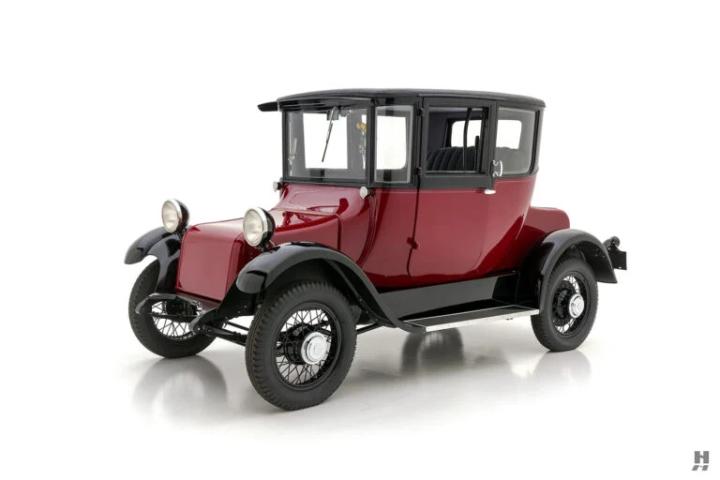1932 Detroit Electric 97B

|
Carrosserie
|
Saloon
|
|
|
Type de carburant
|
Electric
|

|
Transmission
|
Manual
|

|
Couleur extérieure
|
Red and black
|

|
Tapisserie
|
Cloth
|
1932 DETROIT ELECTRIC MODEL 97B BROUGHAM
Detroit Electric is somewhat of an anomaly compared to other companies who adopted “alternative fuels”. The pioneering days of the automobile industry were awash with creative ideas for propulsion beyond just the internal combustion petrol engine. Steam and Electric were popular alternatives before the petroleum infrastructure was fully established. Electrics in particular became popular among wealthy urban women, as they were clean, silent and perfectly suited for the short distances traveled in the city. In the days before Cadillac’s adoption of the Delco System Self-Starter, electrics also had the distinct advantage with no difficult and dangerous starting procedure which, if done improperly could cause serious injury. Even when executed properly, it was not considered particularly lady-like to be yanking on a starter handle. While electrics didn’t particularly flourish in the face of the rapidly developing petrol-engined cars, a reasonably steady market existed to support a few manufacturers. Detroit-Electric stands out as by far one of the most successful and longest-surviving of them all, remaining in production from 1907 through 1939. As steam and electric cars dropped by the wayside, Detroit Electric somehow managed to survive, producing simple, but well-constructed cars that seemed well past their expiry date. Their best year, 1914, saw a production of 4669 cars – putting them decidedly in a niche market when compared to the likes of Ford. But the company persisted even as the fondness for electric cars began to wane after 1916, a time when most production automobiles were offered with electric starters. Styling upgrades such as the addition of “false fronts” kept them up with current trends and even an open speedster proved popular with buyers. Production dropped steadily, even after prices were reduced from a peak of $4000 in 1921. But Detroit Electric persisted, offering buyers the option of conventional bodies supplied by Dodge or Willys-Overland to sit atop their chassis from 1930 onward. Remarkably, the firm soldiered on, still offering the classic (though it was considered positively archaic at the time) “parlor on wheels” body style with tiller steering through the end of production – which some believe persisted until as late as 1941. An estimated 35,000 Detroit Electrics were built over the company’s 35 years, and they remain popular with collectors and enthusiasts.
This 1932 Model 97B Brougham is one such later model from Detroit Electric. This example is one of the finest we’ve had the pleasure to offer, having been restored to concours standards by an experienced marque specialist. The elegant dark burgundy and black paintwork is beautifully finished and the body straight and finely detailed, including a subtle grey coachline. According to historian Beverly Rae Kimes, just 59 Detroit Electric cars were built in 1932, making this a very rare motorcar, indeed. While there is little to differentiate this later model from those in the teens, there are a few subtle differences. Most notable clues include the fenders which were updated with a more contemporary design, a lowered roof height which allowed the cars to clear a standard garage, and revised wheels and headlights. The wire wheels are finished in black with lovely chrome center caps and new blackwall tires lend an understated appearance to the exterior.
To the uninitiated, the unconventional cabin layout can be quite surprising. Most notable is the lack of a traditional steering wheel and pedal arrangement. With the feeling of a lounge on wheels, the driver operates the car via a tiller whilst sat far back on the main bench seat. A flower vase and folding jump seat up front continues the casual salon-like feel as one can easily imagine a trio of socialites using this Detroit in period, chatting away whilst on a shopping run in the city. Like the exterior, the interior is beautifully finished to a very high standard. Grey broadcloth upholstery is featured on the seats, door cards and interior panels. The cabin is simple, yet elegant and inviting, with minimal adornment and basic instrumentation to monitor speed and battery output.
Modern AGM batteries replace the original lead-acid type. The modern batteries are of course more powerful and lighter than the originals, lending improved performance and range.
The quality of the restoration impresses, with scant few imperfections to detract from the fine presentation. As today’s major manufacturers increasingly commit to pure EVs, the electric cars of a century ago warrant a fresh look from collectors and enthusiasts. We are quite pleased to offer this outstanding example, a rare survivor from the later days of Detroit Electric. The quality of the restoration impresses, with scant few imperfections to detract from the fine presentation. With appealing looks and ease of ownership, it is sure to charm the dedicated electric car enthusiast and the newcomer alike.
Offers welcome and trades considered
Price on request
STOCK NUMBER 7166




